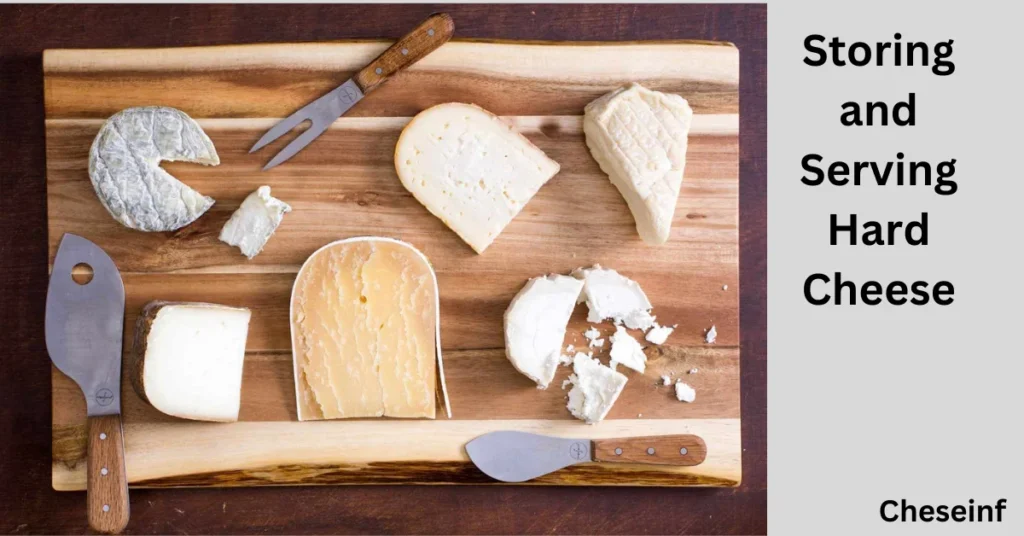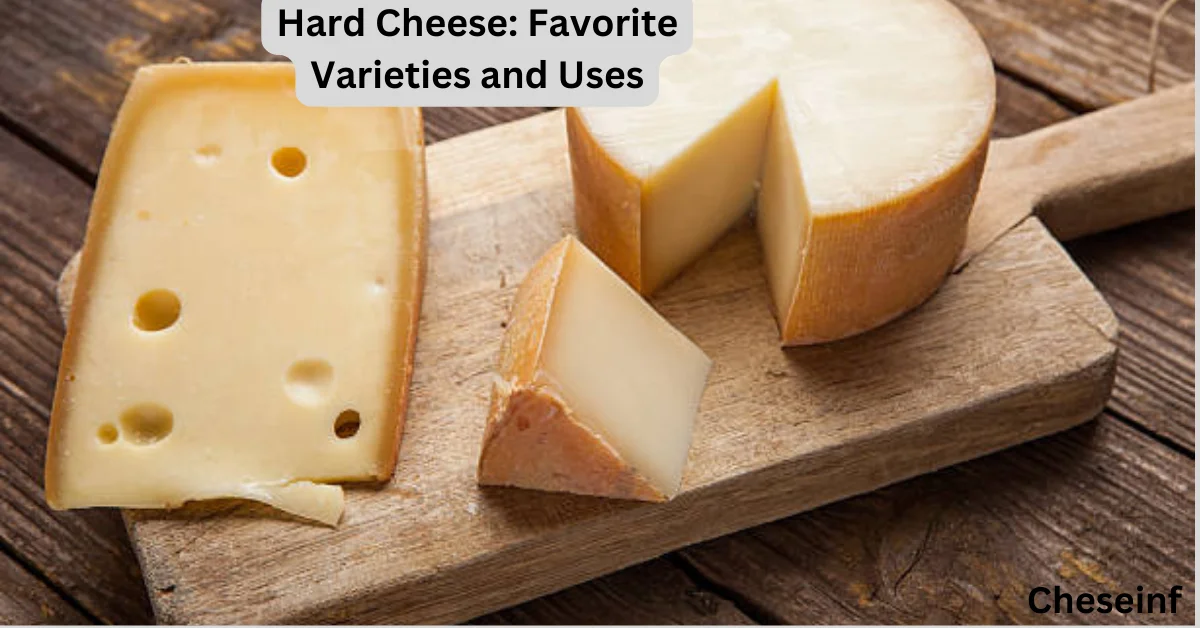Have you ever been in the cheese section at the store, feeling unsure about which hard cheese to pick? With so many choices like Parmesan, Pecorino Romano, Manchego, and Gruyère, it can be a bit overwhelming. But don’t worry! Hard cheeses are incredibly versatile and great for snacking, cooking, or using as a garnish.
In this guide, we’ll explore these popular hard cheeses in detail. You’ll learn how to choose the best one for your needs and get tips on how to store and serve them to bring out their best flavors. Whether you’re new to cheese or a seasoned cheese lover, this guide will provide fresh ideas for enjoying hard cheeses. With this knowledge, you’ll be able to enhance any recipe or cheese platter by selecting the perfect hard cheese.
An Introduction to Hard Cheese:
Hard cheese is a diverse category that includes some of the most popular varieties. These aged cheeses have a firm, crumbly texture thanks to the removal of moisture during the aging process.
Cheddar:
Cheddar is a classic hard cheese that originated in England. It’s made from cow’s milk and has a slightly crumbly texture with flavors that range from mild to sharp, depending on aging time. Cheddar is extremely versatile and used in everything from grilled cheese sandwiches to cheese plates.
Parmesan:
Parmesan is a hard, grainy cheese made from cow’s milk with a very intense, savory flavor. It’s ideal for grating over pasta, pizza, risotto, and salads. Parmigiano-Reggiano and Grana Padano are the most well-known varieties of Parmesan. They have a slightly different flavor profile but can be used interchangeably in recipes.
Pecorino Romano:
Pecorino Romano is a hard cheese made from sheep’s milk. It has a very salty, robust flavor and pungent aroma. Like Parmesan, it’s usually grated or shaved and used to top dishes. Pecorino Romano is a key ingredient in many Italian recipes like bucatini all’amatriciana, cacio e pepe, and tomato bruschetta.
Whether enjoying a cheese board with friends or cooking your favorite Italian dish, hard cheeses add tons of flavor to every occasion. With such a variety available, you’ll never get bored discovering all the tastes and textures these aged cheeses have to offer. So get out there and start eating more cheese – your taste buds will thank you!
Our Top Picks for Hard Cheeses:
Parmesan is one of the most popular hard cheeses. This salty, umami-packed cheese is made from cow’s milk and aged for at least two years. Grate it over pasta, soup, or salad, or enjoy chunks of it on a cheese board.
Aged Gouda is a sweet and nutty cheese that gets intensely flavorful as it ages. Look for gouda that’s been aged at least two years. This caramel-colored cheese pairs beautifully with red wine, nuts, and dried fruit.
Cheddar:
- Cheddar is a versatile cheese that comes in a variety of ages and sharpness.
- Mild cheddar melts well for grilled cheese sandwiches and mac and cheese, while extra-sharp cheddar is best enjoyed in chunks, sliced, or grated as a topping.
- Cheddar also comes in a range of colors, from ivory to deep yellow to orange, depending on the type of milk used.
Pecorino Romano:
Pecorino Romano is a hard, salty cheese made from sheep’s milk. Grate it over pasta, beans, salads, or pizza for a savory, umami kick. Pecorino Romano has a distinctive flavor due to the high butterfat content of sheep’s milk. Look for wheels of Pecorino Romano that have been aged at least eight months for maximum flavor.
Manchego:
Manchego is a Spanish cheese made from sheep’s milk. It has a firm, crumbly texture and a nutty, tangy flavor that gets more complex with age. Manchego is often aged between 3 months to 2 years, resulting in a wide range of flavors. Pair younger Manchego with melon or figs, while older Manchego is best enjoyed on its own.
With so many delicious hard cheeses to choose from, you’ll never get bored. Experiment with different ages, milks, and flavors to find your favorites. A well-stocked cheese board is the perfect way to compare and enjoy a variety of hard cheeses. Buen provecho!
How to Use Hard Cheese in Cooking and Baking:
Add Flavor to Sauces and Soups:
Grate or shred hard cheeses like Parmesan, Pecorino Romano, and Gruyere and stir them into tomato-based pasta sauces, creamy soups like potato leek or mushroom, and chili. They’ll melt into the dish and provide a savory, salty kick of flavor. Try adding a handful of grated Pecorino Romano to minestrone soup or a spoonful of crumbled Gouda to beef stew.
Enhance Casseroles and Gratins:
Hard cheeses are ideal for topping casseroles, gratins, and other baked dishes. Grate cheddar, Gruyere, or Parmesan and sprinkle it over mac and cheese, scalloped potatoes, or egg dishes before baking. The cheese will melt into a golden, bubbling layer as it cooks. You can also make cheese crisps by topping gratins with bread crumbs and shredded hard cheese and broiling until the cheese is melted and lightly browned.
Make Croutons or Cheese Crisps:
Cubed bread tossed in olive oil, herbs, and shredded hard cheese then baked makes delicious cheese croutons. You can also simply top slices of bread with shredded cheese and broil until bubbly for quick cheese crisps. Serve either as a snack, appetizer, or salad topping. Parmesan, Gruyere, and aged Gouda all work well for croutons and crisps.
Add to Sandwiches and Panini:
- Slice or shave pieces of hard cheese like provolone, Swiss, cheddar, or Gruyere and add them to sandwiches, panini, and burgers.
- The cheese provides flavor, creaminess, and texture. Melt the cheese in the sandwich by grilling it in a panini press or skillet.
- Provolone and Swiss melt particularly well, while cheddar and Gruyere have more assertive, nutty flavors.
Using hard cheese in cooking and baking is an easy way to add lots of flavor to your food. Experiment with different varieties and methods to discover your favorites. Your meals will never be short on taste or cheese appeal!
Storing and Serving Hard Cheese:

Keeping Cheese Fresh:
Once you’ve selected your favorite hard cheese, proper storage is key to keeping it fresh and preventing spoilage. Wrap the cheese tightly in plastic wrap, wax or butcher paper, or place in an airtight container like a lidded box or zip-top bag with as much air removed as possible. This protects from oxidation and prevents the cheese from drying out.
Keep hard cheese refrigerated at 40 to 50°F, in the warmest part of the fridge like the butter compartment or deli drawer. This temperature prevents excess moisture build-up but keeps the cheese firm. At room temperature, most hard cheeses will last 1-2 weeks. In the fridge, cheddar and gouda can last 3-6 months, Parmesan up to 8 months, and aged Gruyere up to a year.
Serving Suggestions:
Cheeses for Snacking:
Hard cheeses that are ideally suited for snacking include cheddars, goudas, Gruyere, and Manchego. Slice or cube the cheese and serve with accompaniments like crackers, bread, nuts or fresh and dried fruit. A cheese board with an assortment of meats, olives, cornichons and nuts makes a perfect appetizer.
Cheeses for Cooking:
Parmesan, Pecorino Romano and aged provolone have a salty, savory flavor that is ideal for grating over pasta, risotto or soups. Gruyere and Emmentaler melt beautifully in dishes like fondue, quiche, gratins and croque-monsieur. Cheddar adds a tangy sharpness to mac and cheese, cheeseburgers and potato dishes.
Cheeses for Dessert:
Not all cheeses work in desserts, but a few pair excellently with sweets. Aged goudas have notes of caramel that are delicious with poached pears or apple crisps. Manchego and Parmesan slivers or shavings are a crunchy garnish for everything from panna cotta to affogato. For the ultimate cheese dessert, serve chunks of hard cheese with honey, preserves, chutney or fresh fruit.
Hard Cheese FAQs: Your Pressing Questions Answered
What exactly is hard cheese?
Hard cheeses are aged longer than soft cheeses, giving them a firm, dense texture. The aging process results in a loss of moisture, creating a cheese that can be grated or sliced. Popular varieties of hard cheese include cheddar, Swiss, Parmesan, and pecorino Romano.
How is hard cheese made?
To make hard cheese, bacterial cultures and rennet are added to milk which separates the curds (solids) from the whey (liquid). The curds are then cooked, pressed, and aged. During aging, bacteria and molds break down the curds even further, creating a sharp, tangy flavor. The aging process can take months to years, depending on the type of cheese.
What are some common uses for cheese?
Hard cheeses have a long list of uses:
- Grated or shredded over pasta, rice, and salads
- Melted in sandwiches, on pizza or in casseroles
- Eaten on cheese boards with meats, nuts, and fresh or dried fruit
- Used as a cooking ingredient in dishes like mac and cheese, cheese soufflés, and cheese sauces
- Crumbled over tacos, nachos, chili or soup
- Baked into cheese crisps or cheese crackers
How should I store hard cheese?
Hard cheeses should be tightly wrapped and kept refrigerated. Most varieties will last 2-4 weeks after opening. Store cheese in the packaging it came in, or wrap tightly in parchment paper, wax paper or plastic wrap. An airtight container or zip-top bag also works well.
For best quality, keep the following tips in mind:
• Allow cheese to sit at room temperature for 30 minutes before serving to enhance flavor.
• Change the storage wrapping every time you open the package to prevent drying out.
For longer shelf life, you can also freeze hard cheese for up to 6 months. Grate or slice before freezing and use in cooking after thawing.
• Check for mold before eating—if there’s even a small spot, discard the cheese. Hard cheeses are not ideal candidates for trimming moldy parts.
Conclusion
So there you have it, a quick look at some of the most popular hard cheeses. From cheddar to parmesan, each one has its own distinct flavor, texture, and ideal uses. While they might seem similar at first, trying them side-by-side will reveal subtle (and sometimes major) differences.
Hard cheeses are incredibly versatile—they can elevate your sandwiches, pastas, salads, charcuterie boards, and snacks. Next time you’re at the market, pick up a few varieties and start experimenting. Finding your perfect hard cheese match is a delicious journey every food lover should embark on.

where we’re dedicated to all things cheese! From easy DIY recipes to exploring different cheese types, we’re here to inspire and empower cheese lovers worldwide. Join us as we celebrate the joy of cheese-making and discovery
